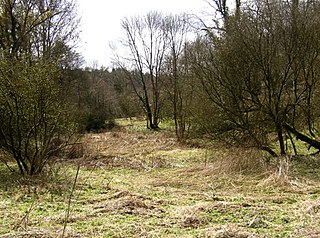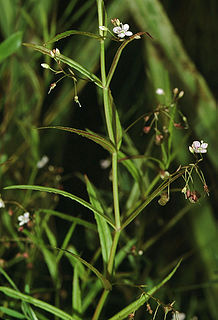
Langmead and Weston Level is a 168.8 hectare biological Site of Special Scientific Interest in Somerset, notified in 1991.

The thumbnail crab, Thia scutellata, is a species of crab whose carapace resembles a human thumbnail. It is found in the North Sea, north-east Atlantic and Mediterranean Sea. It is the only extant species in the genus Thia, although two fossil species are known.

Hardley Flood is a 49.8-hectare (123-acre) biological Site of Special Scientific Interest west of Great Yarmouth in Norfolk. It is part of the Broadland Ramsar site and Special Protection Area, and The Broads Special Area of Conservation.

The East African lowland honey bee is a subspecies of the western honey bee. It is native to central, southern and eastern Africa, though at the southern extreme it is replaced by the Cape honey bee. This subspecies has been determined to constitute one part of the ancestry of the Africanized bees spreading through America.

Ohilimia is a spider genus of the Salticidae family.
Myrceugenia scutellata is a species of plant in the Myrtaceae family.

Charterhouse to Eashing is a 68.4-hectare (169-acre) biological Site of Special Scientific Interest west of Godalming in Surrey.

Medicago scutellata is a plant species of the genus Medicago. It is found throughout the Mediterranean basin. It forms a symbiotic relationship with the bacterium Sinorhizobium meliloti, which is capable of nitrogen fixation. Common names include snail medick and shield medick.

Scutellinia scutellata, commonly known as the eyelash cup, the Molly eye-winker, the scarlet elf cap, the eyelash fungus or the eyelash pixie cup, is a small saprophytic fungus of the genus Scutellinia. It is the type species of Scutellinia, as well as being the most common and widespread. The fruiting bodies are small red cups with distinct long, dark hairs or "eyelashes". These eyelashes are the most distinctive feature and are easily visible with a magnifying glass. The species is common in North America and Europe, and has been recorded on every continent. S. scutellata is found on rotting wood and in other damp habitats, typically growing in small groups, sometimes forming clusters. It is sometimes described as inedible, but its small size means it is not suitable for culinary use. Despite this, it is popular among mushroom hunters due to its unusual "eyelash" hairs, making it memorable and easy to identify.
Rhagoletis scutellata is a species of tephritid or fruit flies in the genus Rhagoletis of the family Tephritidae.
Pterocalla scutellata is a species of ulidiid or picture-winged fly in the genus Pterocalla of the family Tephritidae.

Veronica scutellata is a species of flowering plant in the plantain family known by the common names marsh speedwell, skullcap speedwell, and grassleaf speedwell. It is native to northern North America, including most of Canada and the northern half of the United States. It occurs in moist and wet habitat, such as ponds, marshes, and other wetlands. It is a rhizomatous perennial herb producing a decumbent or upright stem 40 to 60 centimeters in maximum height. It is mostly hairless in texture. The purple-green or reddish leaves are oppositely arranged in pairs about the stem, the blades lance-shaped and smooth-edged. The inflorescence is an open array of several flowers on thin, straight pedicels. The flower is up to a centimeter wide with four lobes, the upper lobe being largest. It is white, blue, or purplish with purple veining. It yields a flat, notched capsule a few millimeters wide.

Sybra is a genus of beetles in the family Cerambycidae, containing the following species:

Cribragapanthia scutellata is a species of beetle in the family Cerambycidae, and the only species in the genus Cribragapanthia. It was described by Pic in 1903.

Sybra umbratica is a species of beetle in the family Cerambycidae. It was described by Pascoe in 1865.
Sybra bioculata is a species of beetle in the family Cerambycidae. It was described by Pic in 1925. It contains four subspecies: Sybra bioculata bioculata, Sybra bioculata quadrinotata, Sybra bioculata sikkimana, and Sybra bioculata tigrina.

Sybra ordinata is a species of beetle in the family Cerambycidae. It was described by Bates in 1873.
Sybra pascoei is a species of beetle in the family Cerambycidae. It was described by Lameere in 1893.
Phytoecia scutellata is a species of beetle in the family Cerambycidae. It was described by Johan Christian Fabricius in 1793, originally under the genus Saperda. It has a wide distribution in Europe, although its populations in Germany and the Czech Republic are reportedly extinct. It measures between 7 to 14 mm.
Milesia scutellata is a species of syrphid fly in the family Syrphidae.













